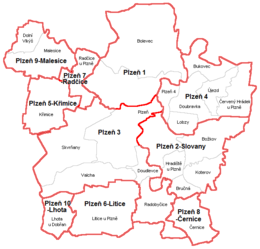Plzeň
![]()
This article is about the Czech city in western Bohemia; for other meanings, see Pilsen (disambiguation).
![]()
Plzeň is a redirect to this article. For the asteroid of the same name see (2613) Plzeň.
Pilsen (Czech: Plzeň, ![]() ˈpl̩.zɛɲ) is the fourth largest city in the Czech Republic, located in the west of Bohemia, and the administrative seat of the Pilsen Region (Plzeňský kraj). Pilsen is known mainly for its Pilsen beer and Škoda factories. The university and diocesan city has a population of about 170,000 and is widely regarded as an important industrial, commercial, cultural and administrative centre. In 2015 Pilsen - together with the city of Mons in Belgium - was European Capital of Culture.
ˈpl̩.zɛɲ) is the fourth largest city in the Czech Republic, located in the west of Bohemia, and the administrative seat of the Pilsen Region (Plzeňský kraj). Pilsen is known mainly for its Pilsen beer and Škoda factories. The university and diocesan city has a population of about 170,000 and is widely regarded as an important industrial, commercial, cultural and administrative centre. In 2015 Pilsen - together with the city of Mons in Belgium - was European Capital of Culture.

Old town with cathedral from east
Geography
Climate and geography
Pilsen is located in the Pilsen Basin at the confluence of the Mies, Radbusa, Úhlava and Úslava rivers. On the south-western outskirts of the city is the České Údolí dam. The city centre is situated around 310 m a.s.l.. Some hills within the city area reach up to 452 m a.s.l.. The old town stands on arkose bedrock. Pilsen belongs to the cool temperate zone with long dry summers, warmer transitional periods and very dry winters with short duration of snow cover. The average annual temperature is 7.5 °C, the average annual precipitation is around 520 mm. The highest measured temperature was 40.1 °C (1983, Pilsen-Bolevec) and the lowest -27.6 °C (1987, Pilsen-Bolevec). The sunshine duration varies annually between 1400 and 1700 hours.
City breakdown
The city of Plzeň is divided into 10 municipalities, which include 31 districts.
- Plzeň 1: Bolevec (Bolewetz) and Severní Předměstí
- Plzeň 2-Slovany: Božkov (Boschkau), Černice (Tschernitz, Czernicz), Doudlevce, Hradiště (Hradischt), Koterov (Kotterau), Lobzy (Lobes) and Východní Předměstí
- Plzeň 3: Doudlevce (Doudlewetz, Daudlewetz), Jižní Předměstí, Litice (Lititz), Nová Hospoda, Radobyčice (Radobschitz), Skvrňany, Valcha, Vnitřní Město and Východní Předměstí
- Plzeň 4: Bukovec (Bukowetz), Červený Hrádek, Doubravka (Dobraken), Lobzy, Újezd (Aujest) and Východní Předměstí
- Plzeň 5-Křimice: Křimice (Krimitz)
- Plzeň 6-Litice: Litice
- Plzeň 7-Radčice: Radčice (Radschitz)
- Plzeň 8-Černice: Černice
- Plzeň 9-Malesice: Dolní Vlkýš and Malesice
- Plzeň 10-Lhota: Lhota

Municipalities of Pilsen
Population
For the 2nd half of the 14th century the town population is estimated at 3000 inhabitants. The Thirty Years' War brought many deaths here as well and thus a massive decrease in the population. In the middle of the 19th century the population exceeded ten thousand. In the following years Pilsen became one of the most important industrial centres of the Austro-Hungarian Empire and the population grew by leaps and bounds. Already in 1890 the city had over 50,000 inhabitants, in the thirties 100,000 citizens and since the fall of communism the number of inhabitants has fluctuated around 170,000.
| Year | 1869 | 1880 | 1890 | 1900 | 1910 | 1921 | 1930 | 1950 | 1961 | 1970 | 1980 | 1991 | 2000 | 2001 | 2002 | 2003 | 2004 | 2005 | 2006 | 2007 | 2008 | 2009 | 2010 | 2011 |
| Population | 23.681 | 38.883 | 50.221 | 68.079 | 80.445 | 88.416 | 114.704 | 124.339 | 132.799 | 148.021 | 170.701 | 173.008 | 166.759 | 164.336 | 163.791 | 164.180 | 162.627 | 162.759 | 163.392 | 165.238 | 169.273 | 169.935 | 168.808 | 167.302 |
Search within the encyclopedia